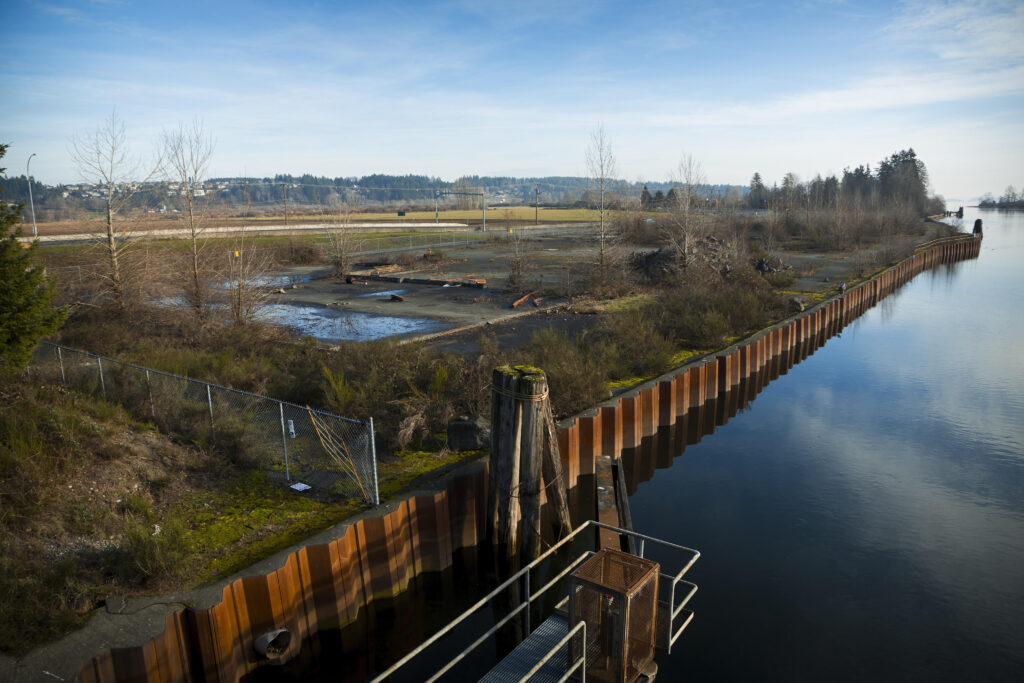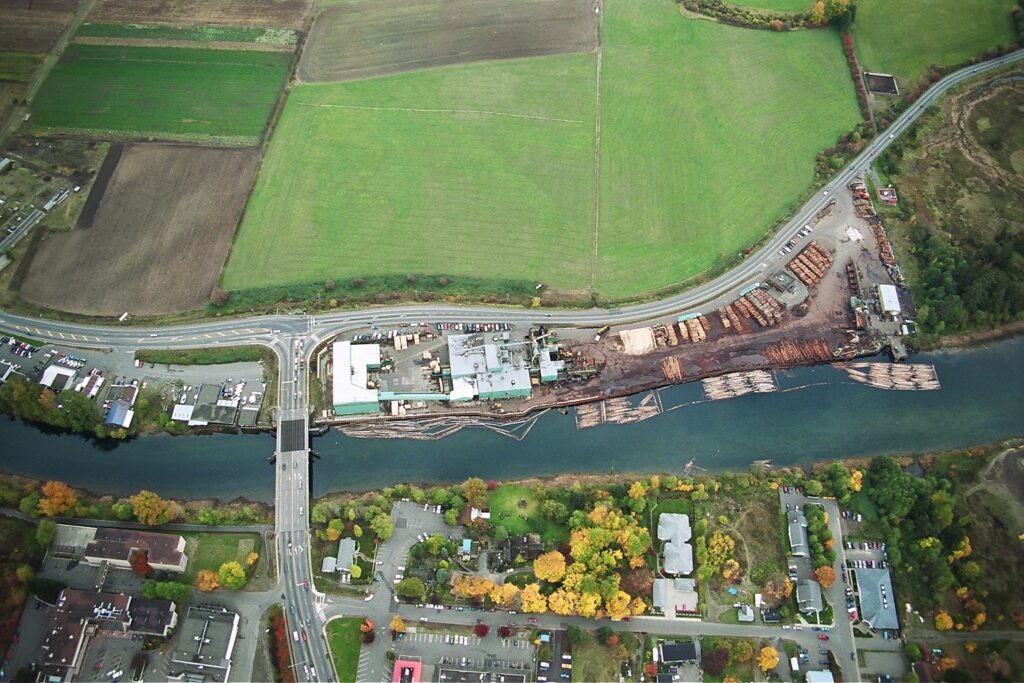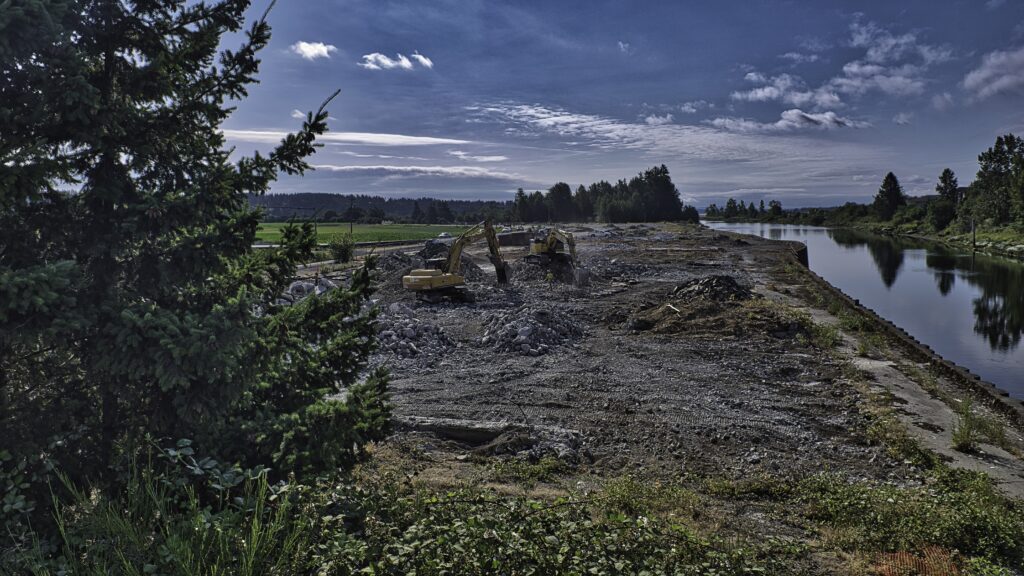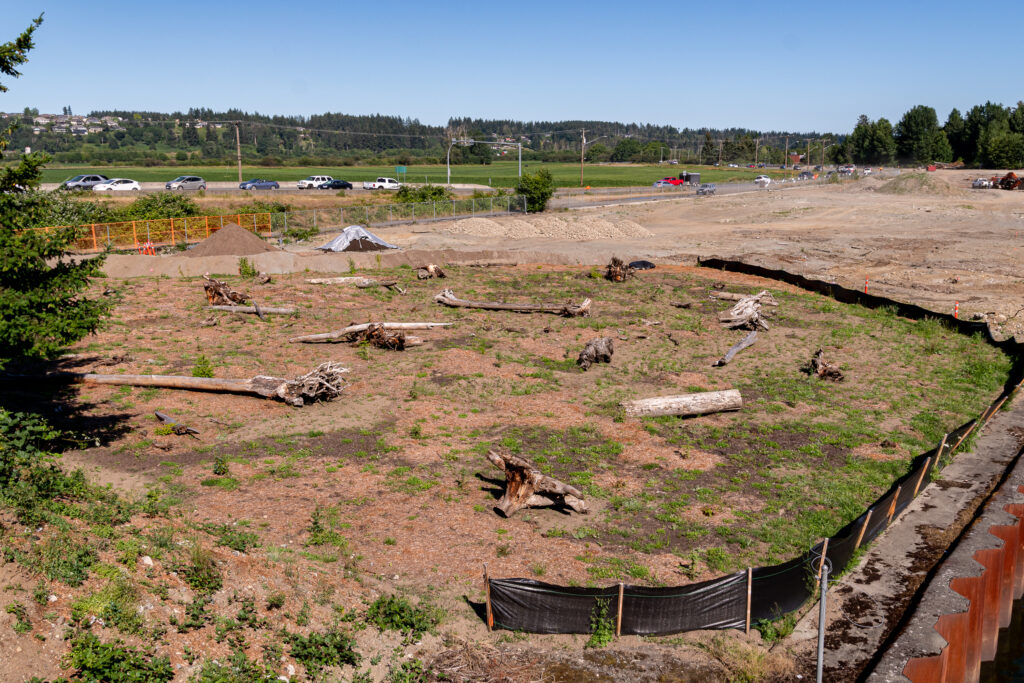A landmark community project in Courtenay is transforming an old industry lot into a restored estuary, which experts say will have a positive impact on the surrounding ecosystem. The site, called Kus-kus-sum, is a collaboration between the K’ómoks First Nation, the City of Courtenay, and an environmental non-profit organization called Project Watershed. The estuary’s revitalization has been underway since 2021, however, the project has stalled because the partners must fundraise to cover the unexpected costs of soil remediation. The Skeena spoke to Caitlin Pierzchalski, Project Watershed’s Executive Director, about the current status of the estuary, the unique coalition of partners involved, and their plan to return the land back to the K’ómoks people.
Estuary Remediation
In 2021, the coalition led by Project Watershed set to work on the initial stages of ecological remediation of an old sawmill site along the Courtenay River. Their long-term goal, and one of the main reasons this site was chosen by Project Watershed, is to reestablish the estuary as a salmon habitat. Pierzchalski says that this restoration project aims to provide crucial support for both juvenile salmon and adult spawners during their migration through the area. This is particularly important because these fish rely on the nutrients supplied by the meeting of saltwater and freshwater in its waterways. The salmon populations are currently struggling due to what locals have dubbed the ‘killing wall’ – a 440 metre-long rusty metal shield built for the sawmill that follows the river bank. The morbid name comes from the wall’s role as a barrier that traps salmon, making them easy prey for hungry seals and their offspring.
“Studies have shown that, as soon as the dyke, road, or steel sheeting is breached, the salmon will actually start to come in over the next couple of tides even.”
Dr. Colin Levings, retired Department of Fisheries and Oceans scientist and Estuary biologist

Once the estuary is restored, the salmon will be able to better hide from predators in the murky vegetation, and survive to spawn and regenerate future populations, said Dr. Colin Levings, retired Department of Fisheries and Oceans scientist and Estuary biologist. “There’s a good chance for success in my view,” he told the Salish Sea Sentinel in 2020, on the projected impact on salmon. “Studies have shown that, as soon as the dyke, road, or steel sheeting is breached, the salmon will actually start to come in over the next couple of tides even.”
“My sense of it knowing Kus-kus-sum … it has to do with the relationship the ancestors had with salmon and how they prepared salmon on the beach.”
Wedlidi Speck, of the Kwakwaka’wakw and K’ómoks Nations
From Village to Sawmill

Long before the sawmill was operating, the estuary land was home to the K’ómoks people and used as a fishery and a traditional burial site. Wooden fish traps are still present on the nearby shore, some estimated to be around 1300 years old by archaeologists. The ancient village was named Kus-kus-sum, which means ‘very slippery.’ “My sense of it knowing Kus-kus-sum … it has to do with the relationship the ancestors had with salmon and how they prepared salmon on the beach,” Wedlidi Speck, of the Kwakwakaʼwakw and K’ómoks Nations, said in the Salish Sea Sentinel piece. The name could refer to “how they rendered parts of the salmon, over a period of time, when salmon is decaying it turns to oil,” they explained.
“We have hundreds and hundreds of volunteer hours every given year on the project, which has been really, really special.”
Caitlin Pierzchalski, Project Watershed’s Executive Director
From 1949 until 2004, the site was home to the Fields Sawmill, which used the Courtenay River for log booming. When it closed, the mill structure was torn down and the land sat unused until Project Watershed became interested in the site as an estuary. In 2016, they held a remediation symposium to gauge the community’s interest in the project. “That got a lot of really positive feedback from the community. They let us know that that’s a project that they wanted us to undertake on the community’s behalf,” says Pierzchalski. Soon the K’ómoks Nation and City of Courtenay were onboard, and the forestry corporation Interfor sold it to Project Watershed and its partners in 2020 for $3.2 million. The K’ómoks Nation has been an essential part of the process, she adds, not only with their financial resources but also “contributing to the kind of ecological and cultural values that we incorporate into the site.”

The project has received additional support from both the provincial government, which has contributed with financial and in-kind support, and the federal government, via Fisheries and Oceans Canada, who have donated and offered technical support. Other environmental non-profits like the Pacific Salmon Foundation have backed the project, and community businesses have jumped on board and even generously offered their services for free, Pierzchalski tells us. Individual donations have also provided a significant boost to their resources. “The community supports the project in a ton of different ways by coming up and volunteering, doing planting and monitoring of the site,” she says. “We have hundreds and hundreds of volunteer hours every given year on the project, which has been really, really special.”
Soiled Plans
In March of this year, the provincial government passed new regulations regarding soil remediation that created new challenges for Kus-kus-sum’s remediation. The Ministry of the Environment’s Protocol 19 introduced new rules that changed how soil contaminants are treated and redistributed, which meant that the previous soil investigations conducted by Project Watershed were no longer sufficient. Subsequent tests of their soil revealed that it is rich in chloride and arsenic, which Pierzchalski says is “very normal for estuarine sites, but it just means that it makes handling of those soils quite challenging.” They are looking to safely move 12,000 cubic metres of soil into a few potential sites nearby, but this new process was not in their original budget.

The organization is seeking to raise an extra $1-1.5 million dollars to cover the additional costs of soil remediation to meet the province’s new protocol. Finding the appropriate soil-receiving site is not an easy task, and requires more testing and consulting to find a new site with a similar level of contaminants to the Kus-kus-sum location. However, Pierzchalski and her partners hope that the future receiving site could turn into another estuary restoration project, putting the soil to good use for more natural revitalization.
Rematriation
“We knew we wouldn’t be able to achieve the project without really widespread community support.”
Caitlin Pierzchalski, Project Watershed’s Executive Director
Once the soil remediation is complete, the group can move forward with the estuary’s revitalization this summer, including removing the steel wall, recontouring the land, and planting native species. Project Watershed has already begun to plant Sitka Spruce, a tree that was decimated by early settlers, and at-risk plants such as Henderson’s checker-mallow.

When the estuary is restored, it will then be rematriated back to the K’ómoks Nation.
‘Rematriation’ – a nod to the Coastal First Nations’ historical matriarchies – means the land would be legally returned to the K’ómoks people. Project Watershed is working to meet regulatory standards for the rematriation, so that “when we have successful restoration, we can prove that the land is stable and doing well through time,” explains Pierzchalski. Ultimately, she tells us, the project has been a collective effort that is the result of the dedication and generosity of many partners, including the wider public. “We knew we wouldn’t be able to achieve the project without really widespread community support,” she says.
If you’d like to donate to or volunteer with the estuary project, go to Project Watershed’s website.




